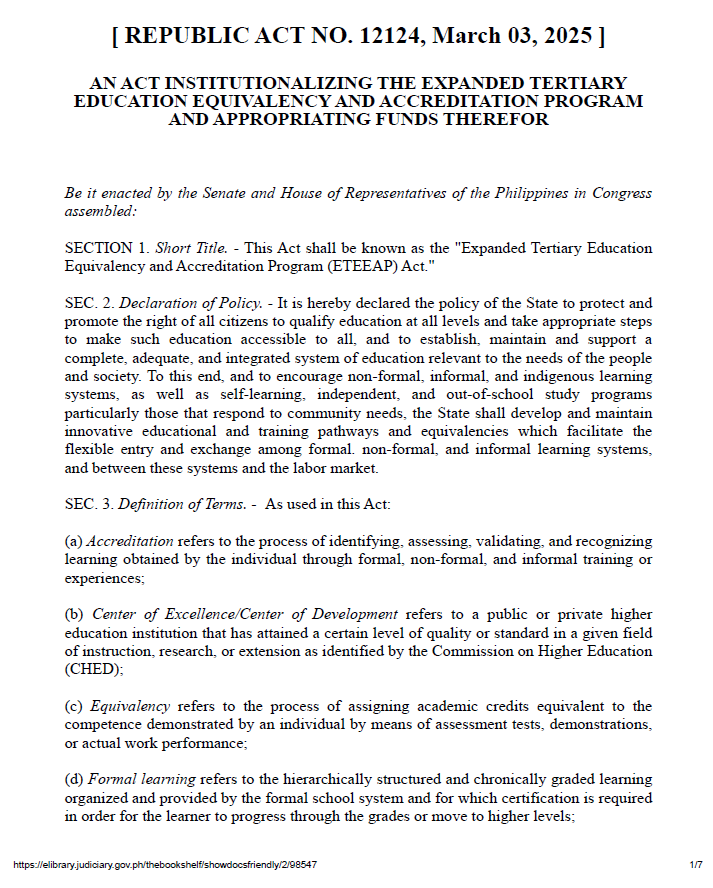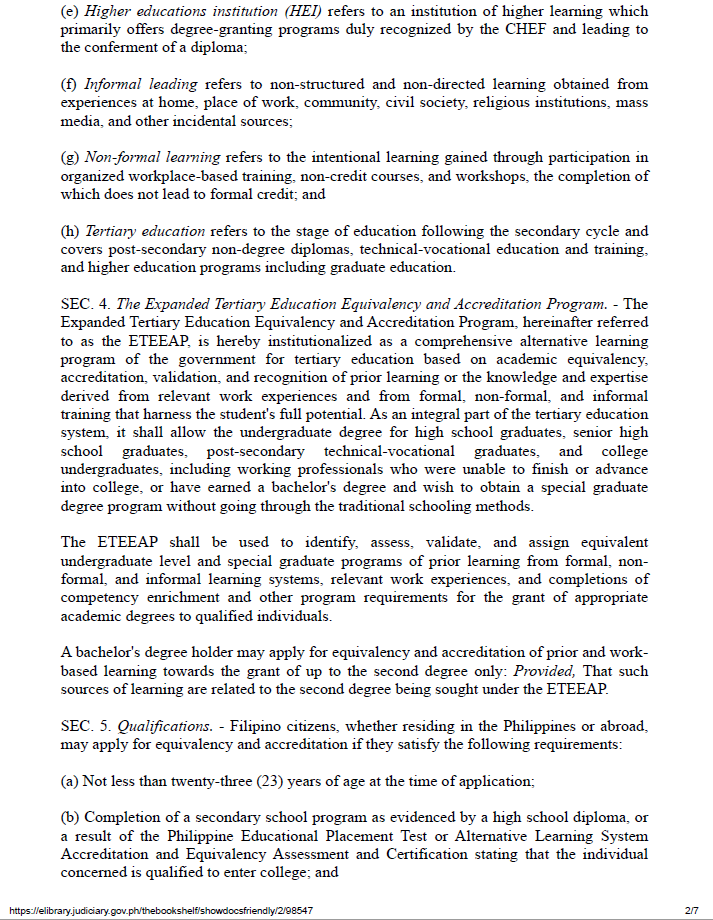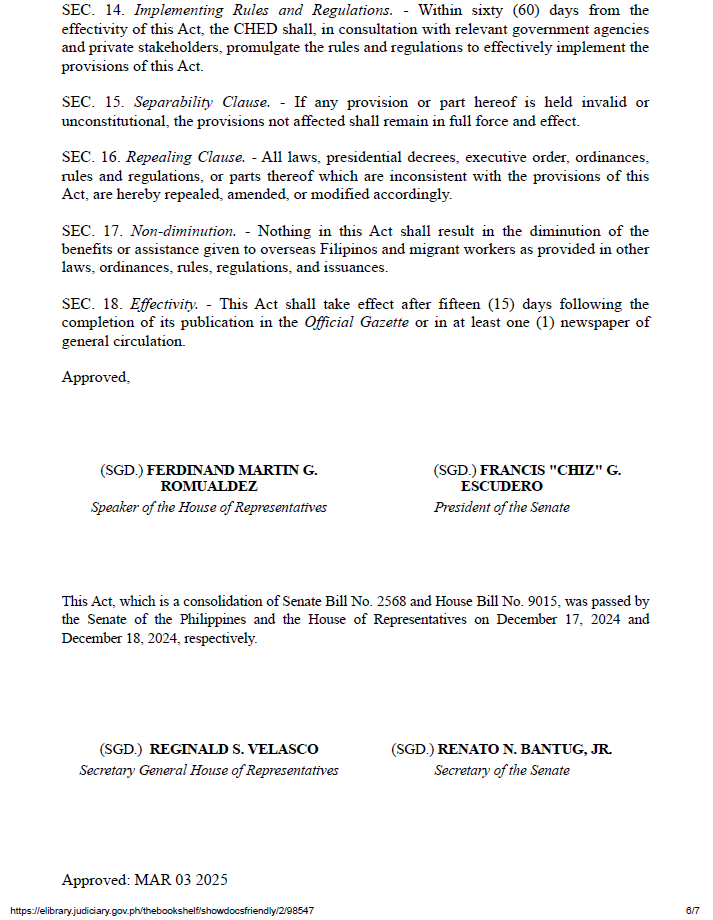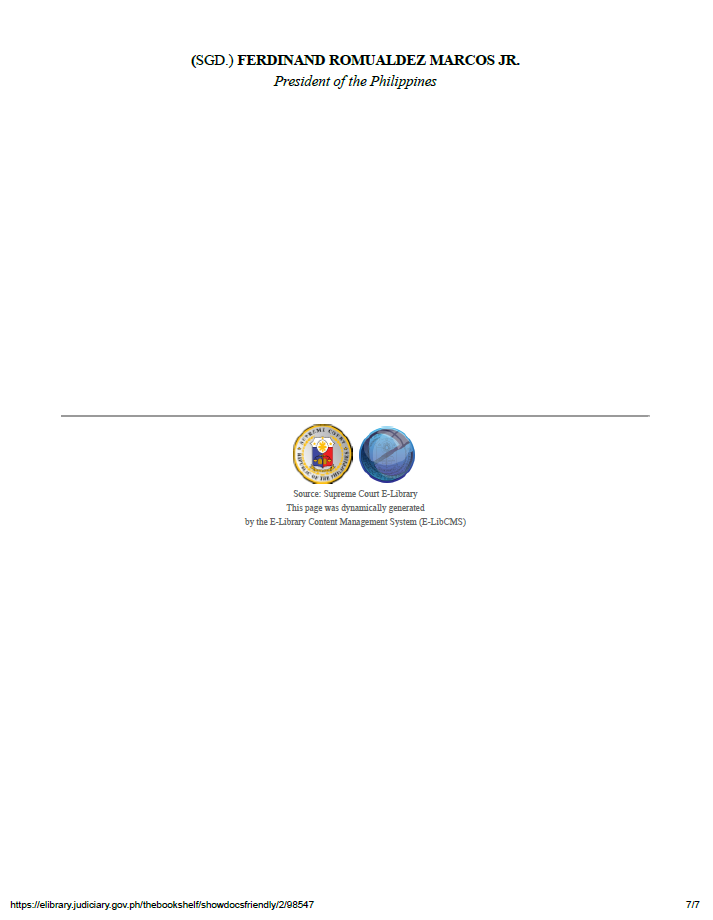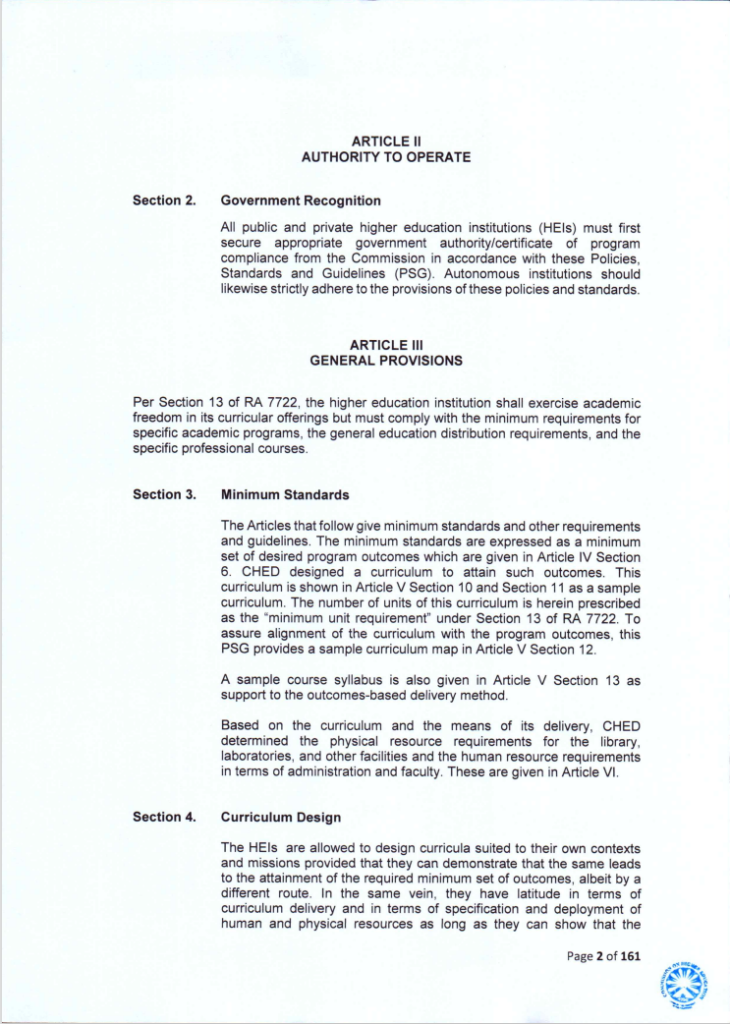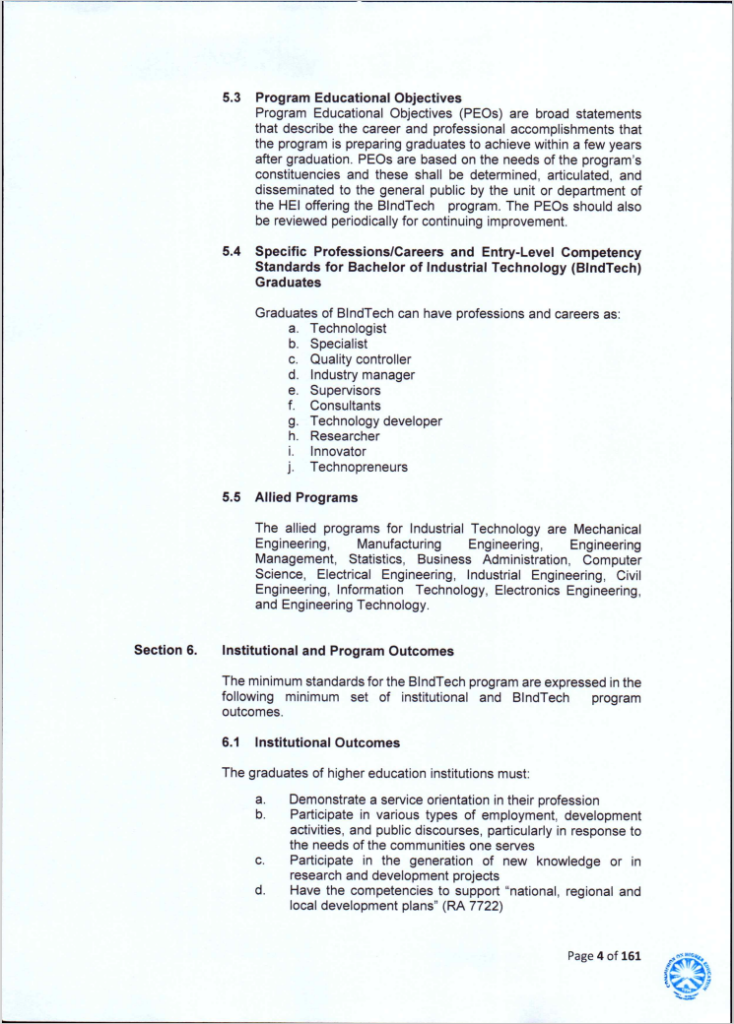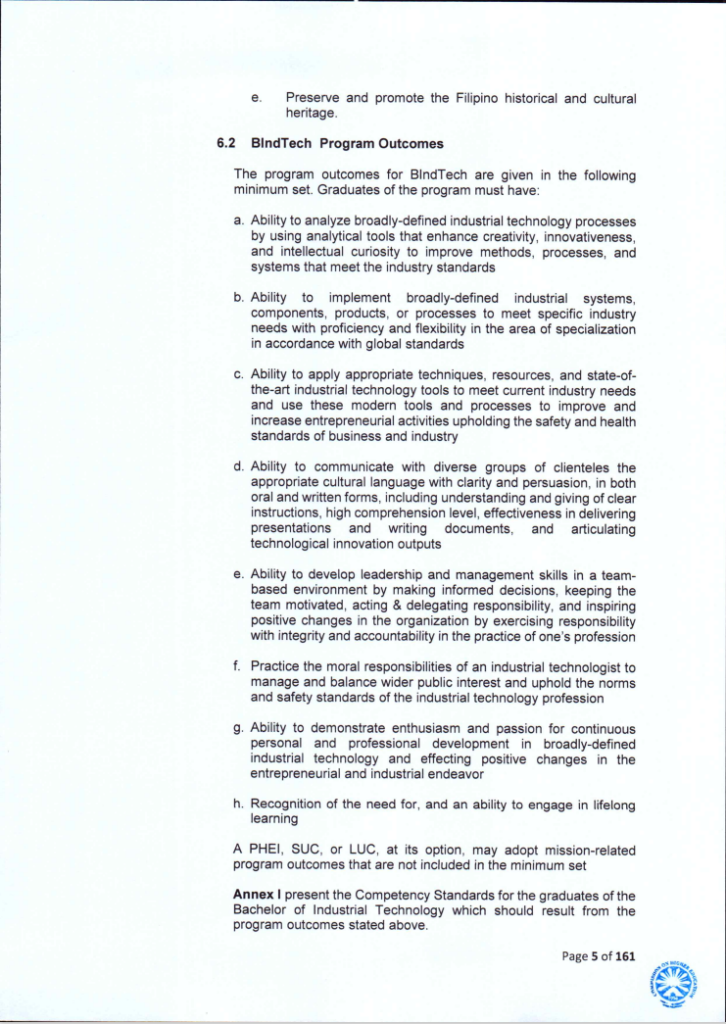This page covers extensive discussion on how state universities and colleges (SUC) as well as private schools and universities evaluate ETEEAP applicants’ credentials. This will help aspiring candidates understand the procedure and prepare their portfolio properly to be able to pass the evaluation and assessments at the first attempt if possible. It is also helpful for those who failed the initial evaluation as to what else they need to prepare and submit to the DHEI to be able to pass the re-evaluation.
Although each ETEEAP DHEI was given autonomy on how to set-up their own system, they still have to closely follow the guidelines provided by the Commission on Higher Education (CHED) in implementing ETEEAP. Accept or admit it or not, there has to be one similar to a point system that should be guiding institutions in evaluating their applicants.
ETEEAP students should be well-rounded in the field where they have experience to be able to qualify into the program. All schools follow the same principle of setting up equivalent score for each evidence presented by the applicants. Although some schools/universities do not mention this openly (or not specifically state that they use the point system), some schools, particularly state universities, do. In the first place there should be a way to determine the equivalent of a credential submitted by the applicant and that is through a standardized scoring system which each school should setup based on CHED’s guidelines. State universities strictly follow this formula and we will use one or two examples of how SUC’s implement this. This will also clear up doubts on the integrity of the evaluation systems used by DHEI’s as some applicants have expressed.
Let’s take a look at one state university’s requirement and compare it with another state university’s evaluation criteria.
The example below was extracted from PUP’s ETEEAP website which contains the requirements an applicant should submit. This is one of the state universities that most members of the ETEEAP community know very well and their website is abundant in needed information about the program. You can find the complete information on their website in this link.
Requirements for Admission
- Letter of intent to avail of the program addressed to the University President through the Executive Vice President and Office Director
- Accomplished ETEEAP application form
- Comprehensive curriculum vitae
- Most recent academic record (Form 137 or original transcript of records)
- Honorable dismissal and subject descriptions from the institution where applicant was last enrolled
- Service record or certificate of employment
- Appointment and duties, functions, and responsibilities (DFR) of each position held
- Latest 2×2 picture (2 pcs) white background
- Original birth certificate (NSO authenticated)
- Original marriage certificate for female applicant (NSO authenticated)
- Other documents, such as but not limited to:
- certificate of participation and/or attendance to seminars/trainings/conference/colloquium or forum attended;
- recognition or award/s received;
- relevant licensure and other professional exams passed;
- copy of research and/or articles published;
- certificate of membership;
- and the like.
In the above example under the ‘Other documents, such as but not limited to:’, there are five categories of documents (in red). These are the ones that needed thorough evaluation and each of these categories have corresponding equivalent (score or points) to enable the applicant gain the minimum requirement for enrollment in the program. Let us now compare this with another state university’s evaluation instrument or credential score guide, Pangasinan State University (PSU), which was proven effective in implementing the ETEEAP because of the high licensure scores of their alumni.
We won’t present the actual or exact evaluation document/instrument they are using, but the criteria or areas in which they evaluate an applicant’s credentials and the maximum score each can earn. In this way, aspiring candidates have idea as to why they failed the evaluation despite submitting more than a hundred pages of credentials, while others who submitted less than fifty pages passed and were able to enroll.
This is a sample evaluation scoring guide to determine ETEEAP applicants’ competencies and qualification. This however does not reflect or contain the exact value the schools are using. The numbers are only used for illustration purposes. While schools use the same principle in evaluating an applicant’s competency, there is a discretionary variation of 5%-10% difference between institutions and evaluators.
SUCs strictly follow the guidance of this instrument while some private institutions are more lenient in some areas but they require the students to enroll more subjects along with added tasks and projects to compensate for the lacking credentials. This explains why some applicants who failed their SUC evaluation passed in some private institutions. The trade off is longer stay with the school and more expense.
As for SUCs, applicants who earn the minimum evaluation score will be required to enroll the maximum number of units. As the score increases beyond the minimum, the required units is lessened. Most of the remaining units the applicants are required to enroll cover the major courses or subjects. If applicants fail to meet the minimum score, it’s either they are not accepted, or required to submit additional requirements.


Now let’s create different scenarios out of the evaluation instrument above. Although the examples below do not reflect exactly how schools evaluate their applicants, these give us the idea on where the evaluation scores are coming from. These help applicants how they should prepare their credentials and which areas they need to focus on.
Let us compare the different examples, and as you look at each of the scenarios, take note of differences on the scores given to the submitted credentials. One more area to focus on is the score given to the relevant training certificates.
Scenario 1 (Applicant 1)
| Documents submitted | Score Earned |
|---|---|
| College credentials (undergraduate) | 18 |
| Five years relevant work experience with complete COE/DFR | 15 |
| 100 relevant training certificates | 5 |
| Drivers license | 3 |
| Birth certificate, passport, application form, intent letter | 0 |
| Total score earned (Failed) | 41 |
Scenario 2 (Applicant 2)
| Documents Submitted | Score Earned |
|---|---|
| High school credential | 10 |
| 10 years relevant work experience with complete COE/DFR | 20 |
| 10 relevant training certificates | 5 |
| Drivers license | 3 |
| Community services (relief operations and tree planting) | 4 |
| Awards and recognitions at work | 6 |
| Birth certificate, passport, application form, intent letter | 0 |
| Total score earned (Failed) | 48 |
Scenario 3 (Applicant 3)
| Documents Submitted | Score Earned |
|---|---|
| High school credential | 10 |
| Relevant TESDA certificates (Considered as vocational) | 4 |
| 10 years relevant work experience with complete COE/DFR | 20 |
| 100 relevant training certificates | 5 |
| Community services (relief operations and tree planting) | 4 |
| Awards and recognitions at work | 6 |
| Rotary club membership | 5 |
| Drivers license | 3 |
| Birth certificate, passport, application form, intent letter | 0 |
| Total score earned (Failed) | 57 |
Scenario 4 (Applicant 4)
| Documents Submitted | Score Earned |
|---|---|
| High school credential | 10 |
| Relevant TESDA certificates (Considered as vocational) | 4 |
| 15 years relevant work experience with complete COE/DFR | 25 |
| 15 relevant training certificates | 5 |
| Community services (relief operations and tree planting) | 4 |
| Awards and recognitions at work | 6 |
| Rotary club membership | 5 |
| Drivers license | 3 |
| Birth certificate, passport, application form, intent letter | 0 |
| Total score earned (Passed) | 62 |
Scenario 5 (Applicant 5)
| Documents Submitted | Score Earned |
|---|---|
| College graduate credential | 20 |
| 10 years relevant work experience with complete COE/DFR | 20 |
| 50 relevant training certificates | 5 |
| Community services (relief operations organizer) | 5 |
| Awards and recognitions at work (International) | 10 |
| Trainor | 2 |
| CS Sub-professional | 3 |
| Drivers license | 2 |
| Birth certificate, passport, application form, intent letter | 0 |
| Total score earned (Passed) | 67 |
Scenario 6 (Applicant 6)
| Documents Submitted | Score Earned |
|---|---|
| High school graduate | 10 |
| 15 years relevant work experience with complete COE/DFR | 25 |
| 30 relevant training certificates | 5 |
| Community services (relief operations organizer) | 5 |
| Awards and recognitions at work (National level) | 8 |
| Trainor | 2 |
| CS Sub-professional | 3 |
| Drivers license | 2 |
| Birth certificate, passport, application form, intent letter | 0 |
| Total score earned (Passed) | 60 |
Scenario 7 (Applicant 7)
| Documents Submitted | Score Earned |
|---|---|
| High school credential + Vocational | 14 |
| 20 years relevant work experience with complete COE/DFR | 30 |
| 10 relevant training certificates | 5 |
| Drivers license | 3 |
| Community services (relief operations and tree planting) | 4 |
| Awards and recognitions at work | 6 |
| Birth certificate, passport, application form, intent letter | 0 |
| Total score earned (Passed) | 62 |
We hope the above information is helpful in your ETEEAP journey.













